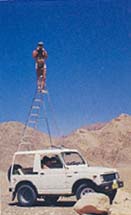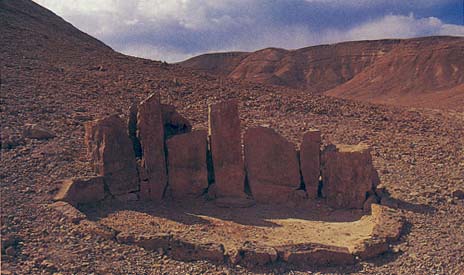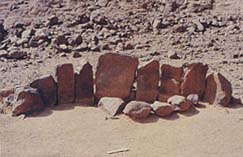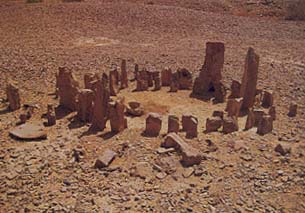Desert Shrines Dedicated to Imageless Gods
Sidebar to: Picturing Imageless Deities049
“I don’t know about a motorbike,” archaeologist Uzi Avner (pictured below) insists, responding to rumors that he carries out his fieldwork on a motorcycle. Instead, Avner says he uses a jeep to get to most of the nearly 1,500 archaeological sites he has surveyed in the Negev and Sinai deserts.

For 25 years Avner has documented desert sites for the Israel Antiquities Authority (IAA). He has served as the IAA’s District Archaeologist of the Southern Negev for the past seven years, leading a team that surveys, excavates and preserves as many of the area’s sites as possible before real estate development or army maneuvers destroy them forever. Several hundred sites have already been studied through his team’s efforts, but the work is a constant struggle. “I’m trying to protect the archaeological remains and the cultural heritage of the Negev as much as I can,” he says. “I do not always succeed.”
Avner’s interest in archaeology began in the late 1960s. He had spent some time in the Israeli army and on a kibbutz and decided he wanted to learn yediat ha’retz—a Hebrew term encompassing the natural sciences, history and archaeology. He began work as a guide and teacher at the Eilat Field School in the southern Negev. In 1969, Avner became the first resident archaeological inspector for the Eilat area.
Most of Avner’s archaeological work has concentrated on the southern Negev. Thinking he would find relatively few sites, with sparse and scattered populations and primitive cultures, Avner actually discovered thousands of sites and “a full sequence of very rich human activity and creativity … over the last 10,000 years.” In the Uvda Valley alone, Avner documented nearly 400 sites dating from the 6th to the 2nd millennium B.C.E., some containing remains of sophisticated agricultural communities.
But the Negev’s ancient cult remains are probably the most unexpected of Avner’s discoveries, in particular the numerous masseboth, or standing stones, scattered throughout the area. These stones range in date from the 11th millennium B.C.E. to the early 7th century C.E., though most are concentrated in the period running from the 6th to 3rd millennium B.C.E. (The group of masseboth shown 050on the previous page probably dates to the late fourth millennium B.C.E. The tallest stone is about 3 feet tall.)

Masseboth were erected wherever people camped, settled or traveled, Avner discovered. Some were set up near where ancient peoples had dug into the earth, near copper mines and graves. Avner suggests that ancient peoples believed digging into the ground was a violent act, a penetration of the earth/mother goddess, and set up the stones as shrines to appease her.
“In the beginning it was almost inappropriate to call them shrines,” Avner says, pointing out that scholars did not have enough information about the standing stones to draw any solid conclusions. Now, after collecting vast amounts of material, Avner can demonstrate that some of the masseboth—found in singles and pairs, as well as in groups of three, five, seven and nine—represent groups of deities. One such group of nine masseboth, located at Wadi Sa’al in Eastern Sinai (below), dates to the fifth or fourth millennium B.C.E. The middle stone is about 4 feet tall. “[These masseboth] are very similar in appearance to groups of deities presented in sculpture throughout the Near East, in Egypt, Mesopotamia, Anatolia and the Levant,” Avner notes. “But the difference between the two trends is a profound theological one.” Masseboth represent deities in an abstract, non-anthropomorphic way. This form of aniconism, developed by desert populations, suggests a theology that prohibits figural representations of the divine. Such prohibitions are also found in Israelite, Nabatean and Arabic religions, all of which have desert roots.

Larger groups of masseboth—one site in Eilat contains 98 stones—represent ancestor spirits, Avner suggests, because these larger groups of usually small masseboth are sometimes connected with cemeteries. Avner is currently studying a burial ground near Eilat (shown below) dating from the sixth to the fifth millennium B.C.E., where he has found masseboth both outside and inside tombs and in an open sanctuary. The larger stones, both about 2 feet tall, are believed to represent a pair of deities. The smaller stones probably represent ancestor spirits.
Maneuvering between his archaeological duties and work on a Ph.D. at Hebrew University, Avner is concerned with more than just the history of the Negev and Sinai deserts. He’s concerned with their future. Today 80 percent of the Negev is reserved for army training, and developers clamor for whatever portions of the desert they can get. “We are constantly losing archaeological remains and cultural heritage,” Avner says. “Today, with the accumulating material, one can see how much of Israel’s religious and philosophical past is rooted in the desert. The major question is, How can we preserve at least some of it for future generations and scholars?”

